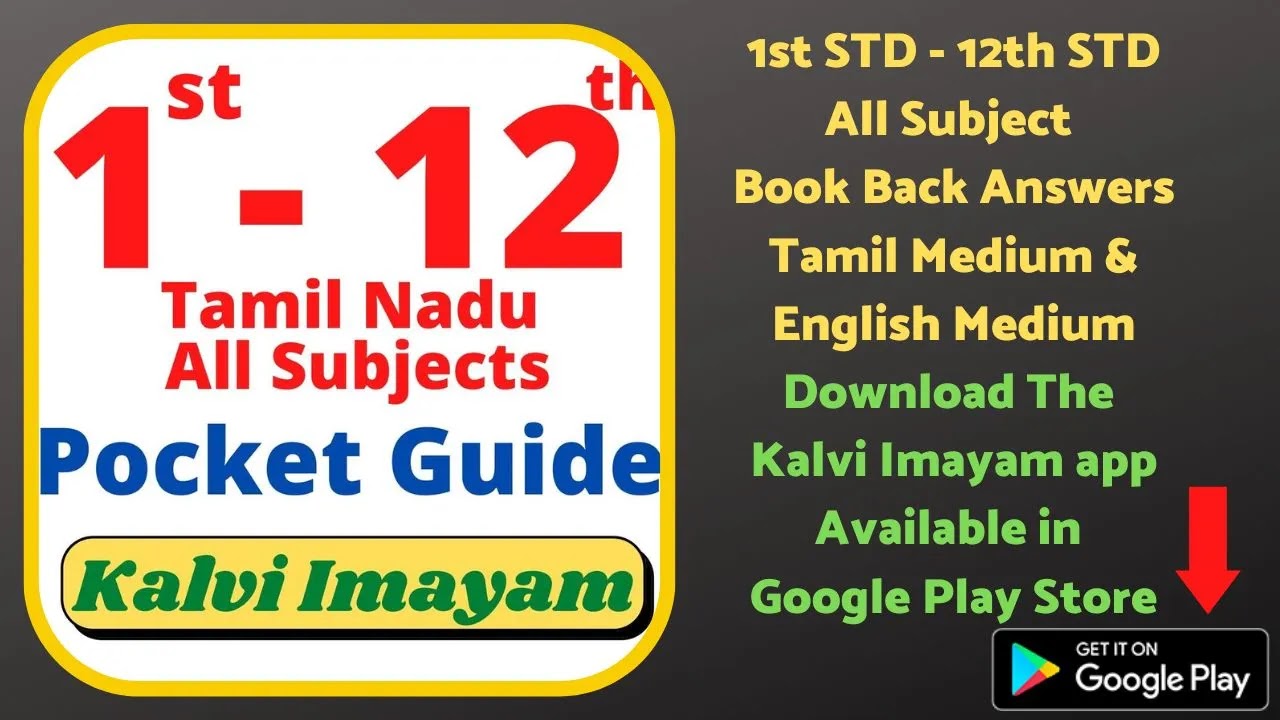5th Science Guide Term 3 Lesson 1 Our Environment
Tamilnadu Samacheer Kalvi 5th Science Solutions Term 3 Chapter 1 Our Environment
5th Science Tamil Medium Guide. 5th Science Term 3 Lesson 1 Our Environment Book Back and Additional Questions and Answers. TN Samacheer kalvi guide Science Solutions. 5th All Subject Text Books Download pdf. Class 5 / Fifth Standard Term 1 Lesson 1 Organ System question answers. Class 1 to 12 Book Back Guide.

-
5th Std SCIENCE Term 1, 2, 3 All Unit Book Back & Addition Question and Answers – Tamil Medium & English Medium
-
5th All Subject Guide – Tamil Medium & English Medium
5th Science Guide Our Environment Text Book Back Questions and Answers
Evaluation
I. Choose the correct answer:
Question 1.
Which of the following produces more milk?
(a) cow
(b) yak
(c) buffalo
(d) goat
Answer:(a) cow
Question 2.
Poultry farming is rearing and breeding of _______.
(a) chickens
(b) cows
(c) avian species
(d) animal
Answer:(c) Avian species
Question 3.
_______ is the best fertilizer.
(a) Vermicompost
(b) Fruits
(c) Synthetic Fertiliser
(d) Urea
Answer:(a) Vermicompost
Question 4.
_______ is more profitable than Agriculture.
(a) Dairy farm
(b) Farming
(c) Cultivation
(d) Poultry
Answer:(b) Farming
Question 5.
The poultry farm is famous in _______ district in Tamil Nadu state.
(a) Ariyalur
(b) Salem
(c) Namakkal
(d) Thanjavur
Answer:(c) Namakkal
II. Fill in the blanks:
Question 1.
There are ________ breeds of cattle in IndiaAnswer:26
Question 2.
The milk of_______ has more nutrients than cow’s milk.Answer:Buffalo
Question 3.
_______ contains high amount of fiber.Answer:Roughage
Question 4.
Droppings of poultry birds are used as.Answer:Manure
Question 5.
Vermicomposting is a method of transforming _______ into a nutrient rich fertilizer.
Answer:Organic waste
III. Match the following:
- Surti – a. Egg
- White revolution – b. Transportation
- Layers – c. Leguminous plants
- Green manure – d. Buffalo
- Cattle – e. Milk
Answer:
- Surti – a. Buffalo
- White revolution – b. Milk
- Layers – c. Egg
- Green manure – d. Leguminous plants
- Cattle – e. Transportation
IV. Say True or False:
Question 1.
Farming is done on a commercial scale.
Answer:True
Question 2.
Vermicompost caribe used to dean sewage.
Answer:True
Question 3.
Leguminous plants fix nitrogen in the leaves of the plants.
Answer:False
Correct Statement:
Leguminous plants fix nitrogen in the roots of the plants.
Question 4.
Namakkal district is famous for dairy farms.
Answer:False
Correct Statement:
Namakkal district is famous for poultry farms.
Question 5.
Murrah is a buffalo breed.
Answer:True
V. Answer briefly:
1. What is farming?
Answer:
- Farming is the activity of growing crops and raising livestock.
2. Mention the types of farming.
Answer:
- Large scale farms
- Middle-sized farms
- small-sized farms
3. Write a note on a poultry farm.
Answer:
- In poultry farms, avian species are reared and bred for the purpose of egg, meat, or both.
- Fowls, ducks, geese, turkeys, and some varieties of pigeon are the most commonly reared species.
- Proper management of poultry includes methods of hatching, rearing, housing, sanitation, prevention of diseases, and a sound marketing system.
4. What is farmyard manure?
Answer:
- A common form of animal manure is farmyard manure.
- It contains the feces and urine of different livestock like horses, cattle, pigs, sheep, chickens, turkey, and rabbits.
- It contains nutrients like nitrogen, phosphorus, and potassium. It increases the capacity of soil to hold more water and nutrients.
5. Define vermicompost.
Answer:
- Vermiculture or Vermicomposting is a method of transforming organic wastes such as waste papers, leaves, pieces of wood, etc., into a nutrient rich fertilizer using earthworms.
- It is a healthy and clean way to eliminate wastes going into our landfills.
- It keeps the environment clean.
- Earthworms eat the organic wastes and excrete it in the form of castings. This is known as vermicompost.
VI.Answer in detail:
1. What are the uses of animal products?
Answer:
- Milk is used to produce milk products like cheese, butter, curd, etc.
- Cattle dung is used as manure. It is also used as fuel and for the generation of biogas.
- Panchagavya is an ayurvedic medicine used in agriculture to control pests and fungi. It is a mixer of dung and urine of cows, fresh milk, curd, jaggery, and ghee.
- Leather goods are manufactured from cattle hides.
2. How will you manage a poultry farm?
Answer:
Poultry birds need a clean environment. The following measures should be taken in order to avoid diseases.
- Poultry houses should be clean and disinfected.
- It should have windows for ventilation.
- Light is essential for high egg production.
- Poultry birds need clean and freshwater.
- Timely vaccination is necessary to prevent diseases.
Activities:
Activity 1.
Visit an animal farm in your area and prepare a list of animals domesticated there. Also, find out the products you can get from there.
- Cow – Milk
- Goat – milk
- Buffalo – milk
- Hen – Eggs
- Duck – Eggs
Activity 3.
Visit a veterinary hospital in your area and find out the common diseases found among the cattle in your area. Try to know how such diseases can be prevented.
Answer:
|
Common cattle disease |
Prevention |
|
Anthrax |
Regular annual vaccination of animals |
|
Black quarter |
(i) Regular vaccination |
Activity 4.
Fill in the blanks using the words given below.
(Oilseeds, Egg, Honey, Food grains, Fish)
Question 1.
Green revolution : _____.Answer:Food grains
Question 2.
Blue revolution : _____.Answer:Fish
Question 3.
Silver revolution : _____.Answer:Eggs
Question 4.
Gold revolution : _____.Answer:Honey
Question 5.
Yellow revolution : _____.Answer:Oilseeds
5th Science Guide Our Environment Additional Questions and Answers
I. Choose the correct answer:
Question 1.
_______ is the cultivation of land and breeding of animals and plants to provide food, fiber, wood & medicinal plants.
(a) Agriculture
(b) Floriculture
(c) Apiculture
Answer:(a) Agriculture
Question 2.
_______ includes all living things such as plants and animals.
(a) Physical environment
(b) Biological environment
(c) Natural environment
Answer:(b) Biological environment
Question 3.
_______ is the biggest buffalo milk producer in the world.
(a) China
(b) India
(c) Japan
Answer:(b) India
Question 4.
________ medicine deals with prevention, diagnosis, and treatment of disease, disorder, and injury for domestic and non-domestic animals.
(a) Dentist
(b) General
(c) Veterinary
Answer:(c) Veterinary
Question 5.
_______ are affected by internal parasites like roundworm and tapeworm.
(a) Farm animals
(b) Camels
(c) Poultry birds
Answer:(c) Poultry birds
II. Fill In the blanks:
Question 1.
Leather goods are manufacture from _______.Answer:cattle hides
Question 2.
_______ & _______ disease and _______ are some of the common diseases found among cattle.
Answer:Foot and mouth disease and anthrax
Question 3.
_______ was called as the father of white revolution.
Answer:Dr. Verghese Kurien
Question 4.
________ is used as a fertilizer for the soil and it improves the properties of the soil.
Answer:Vermicompost
Question 5.
_______ helps in the suppression of weeds and the prevention of soil erosion.
Answer:Green manure.
III. Say True or False:
Question 1.
Krishnagiri district of Tamilnadu is the biggest cattle form in Asia.
Answer:True
Question 2.
Bhadawari and Surti are the buffalo breeds found in India.
Answer:True
Question 3.
Chicken occupies 90% of the total poultry.
Answer:True
Question 4.
Whitelegon is the most egg yielding breed in the world.
Answer:True
Question 5.
Common earthworms are used for vermicomposting.
Answer:False
Correct statement:
Common earthworms are not used for vermicomposting.
IV. Match the following:
1.
- Murrah – a. Gujarat
- Poultry – b. Punjab
- Jaffrabadi c. Bacteria
- Foul cholera – d. Fertilizer
- Manure – e. Namakkal
Answer:
- b
- e
- a
- c
- d
2.
- Ongole – a. Tamil nadu
- Birds for meat – b. Fix nitrogen
- Kangayam – c. Phosphorus
- Animal manure – d. Andhra pradesh
- Leguminous plant – e. Broilers
Answer:
- d
- e
- a
- c
- b
V. Answer briefly:
1. What is dairy farming?
Answer:
- Dairy farming is a type of agriculture that focuses on the extraction of milk and preparation of various milk products like cheese, butter, curd, etc.
2. Name some cattle breeds of India?
Answer:
- Gir, Sahiwal, Red Sindhi, Kangayam, and Ongole are some of the cattle breeds found in India.
3. Name some buffalo breeds of India.
Answer:
- Murrah, Jaffrabadi, Bhadawari, and Surti are the buffalo breeds that are found in India.
4. What food do cattle need?
Answer:
- Cattle need nutritious feed in order to be healthy and to produce high milk yield.
- The cattle feed includes roughage and concentrates.
- The roughage contains a high amount of fiber and it includes fodder, hay, straw, and silage.
- Concentrates include broken grams, cereals, millets, rice polish, cotton seeds, and oil cakes.
- Apart from these feeds, cattle need an adequate amount of freshwater.
5. How to reduce the spread of diseases in cattle?
Answer:
- Maintaining proper sanitation is necessary to stop the spread of these diseases.
- Timely vaccination can prevent most of the diseases.
6. Name the poultry farms found in Tamilnadu.
Answer:
- In Tamil Nadu famous poultry farms are found in places like Namakkal, Palladam, and Chennai.
7. What is Liquid Gold?
Answer:
- Honey is an exciting source of natural sweet. It is also called Liquid Gold.
8. How are fowls classified?
Answer:
Fowls are classified on the basis of their utility to man. They are:
- Meat type (broiler),
- Egg type (egg layer)
- Dual type.
9. What are the minerals present in the egg?
Answer:
- Egg contains minerals like calcium, phosphorus, and sodium, and vitamins Like Bi, B2, and D.
10. Name the different types of manure.
Answer:
- Animal manure, green manure, and compost manure are different types of manures.
11. What is manure?
Answer:
- Manure is an organic matter used as fertilizer.
- It is mostly derived from animal and plant residues.
- It increases the fertility of the soil by adding nutrients such as nitrogen, phosphorus, and potassium.
- It is a natural form of fertilizer and it is cheaper.
12. What is green manure?
Answer:
- This is manure obtained by decomposition of green leaves, twigs of trees, shrubs, and herbs.
- Leguminous plants like clover are used for this purpose.
- These plants are ploughed in the soil.
- They fix nitrogen in the root of the plants.
- They also help in suppression of weeds and prevention of soil erosion.
13. What is compost?
Answer:
- Compost is obtained by decomposition of organic matter like crop residues, animal wastes, and food wastes by various microorganisms like bacteria and fungi under controlled conditions. These microorganisms break down organic matter into simpler substances.
14. Name some organic matters which are biologically degradable and used in vermicomposting.
Answer:
- Crop residues like rice straw, rice husk, tea wastes, and tobacco wastes.
- Fruit and vegetable wastes.
- Animal wastes like cattle dung, poultry droppings, and droppings of goat and sheep.
15. Name some earthworms that are used in vermicompost.
Answer:
Red wigglers, European nightcrawlers, and African nightcrawlers.
VI. Answer in detail:
1. How are poultry birds useful to us?
Answer:
- Egg, meat, and manure are the three main benefits.
- Poultry birds are a good source of nutritive food.
- Eggs laid by them are rich source of protein. These are easily digestible. They contain minerals like calcium, potassium, and iron, vitamins, and a moderate amount of fat.
- Their feathers are used for making pillows and quilts.
- Dropping of the poultry birds is used as manure. It is highly valuable for crops.
2. Write a note on poultry disease.
- Poultry birds affected by the virus suffer from fever and diarrhea.
- Foul cholera is caused by bacteria.
- Overexposure to wet and cold conditions causes cramps in poultry birds.
- Poultry birds are affected by internal parasites like roundworm and tape worm. They are also affected by external parasites like flees, lice, ticks, etc.



